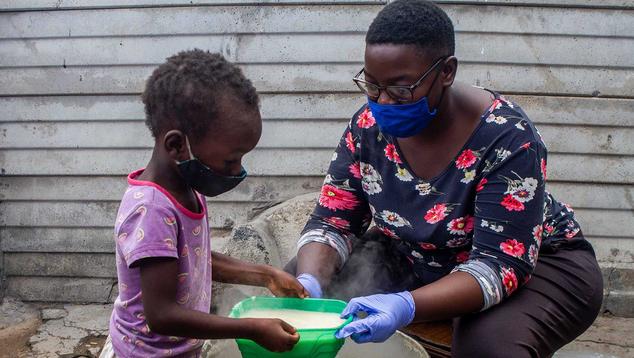Before the pandemic, progress was already stalled on meeting sustainable development goal (SDG) targets 2.1 and 2.2: ending hunger and ensuring access to safe, nutritious and sufficient food for all people, all year round; and eradicating all forms of malnutrition.
But the recently released The State of Food Security and Nutrition in the World report shows major setbacks in the shadow of the pandemic. In this context, the world was headed in the wrong direction in 2020 and is in danger of not reaching either of these targets by 2030.
The report, which was released in July, draws on data from many sources, including food security data collected for the Food and Agriculture Organization of the United Nations in the Gallup World Poll*, to offer the first global assessment of how much bigger the world's problems with food insecurity and malnutrition became during the pandemic and to show how much more challenging it will be now to fix these problems.
Key Findings
For the first time in years, the proportion of people in the world facing hunger rose in 2020.
After remaining basically unchanged for five years, the prevalence of undernourishment -- the FAO's traditional indicator of the extent of hunger -- increased from 8.4% to around 9.9% in the span of one year. In terms of sheer numbers, an estimated 720 million to 811 million people faced hunger in 2020, up by more than 100 million from the year before.

Custom graphic. The number of undernourished people around the world continued to climb in 2020. The prevalence of undernourishment increased from 8.4% to 9.9% between 2019 and 2020. An estimated 720 million to 811 million people faced hunger in 2020, up from 650 million in 2019.
By 2030, these numbers are expected to decline, but they are still anticipated to be just under 660 million. This is about 30 million more compared with a scenario in which the pandemic had not occurred, which shows how lasting the effects are likely to be.
In 2020, the number of people who did not have access to adequate food increased as much in one year as it had in the past five years combined.
Moderate or severe food insecurity at the global level has slowly been rising since 2014, when the FAO first started annually collecting data using the Food Insecurity Experience Scale (FIES) through Gallup's World Poll. But in 2020, moderate or severe food insecurity rose nearly as much as it had in the previous five years -- combined.
It is estimated that three in 10 people worldwide (30.4%) did not have access to adequate food in 2020. This represents an increase of roughly 320 million more people in one year, with totals rising from 2.05 billion to 2.37 billion people worldwide.
Asia was home to the bulk of the world's food insecure. Half of the 2.37 billion people facing moderate or severe food insecurity were living in Asia (1.2 billion), while one in three lived in Africa (799 million) and more than one in 10 lived in Latin America and the Caribbean (267 million).

Custom graphic. Moderate or severe food insecurity has been climbing slowly for six years and now affects more than 30% of the world population. In Africa, it affects nearly 60%, while in Asia it affects 26%. In Latin America and the Caribbean, 41% experience food insecurity, as do nearly 9% of people in Northern America and Europe.
The sharpest increases in moderate or severe food insecurity in 2020 occurred in Latin America and the Caribbean and in Africa. In Northern America and Europe, food insecurity increased for the first time since the FAO started collecting FIES data.
Malnutrition -- in all forms -- remains a challenge.
Although the latest estimates do not account for the effects of the COVID-19 pandemic, the world's progress thus far on each of the seven global nutrition targets suggests malnutrition remains a considerable challenge.
- In 2020, 22% of children younger than 5 (149.2 million) were affected by stunting, 6.7% (45.4 million) suffered from wasting and 5.7% (38.9 million) were overweight. The actual figures, particularly for stunting and wasting, are expected to be higher because of the pandemic.
- Data also show that little progress has been made to reduce low birth weight since 2012. New low birthweight estimates will be released in early 2022. At the same time, adult obesity continues to rise, with the global prevalence increasing from 11.8% in 2012 to 13.1% in 2016. Updated adult obesity estimates will be released in late 2021.
- Nearly one in three women of reproductive age (29.9%) globally were still affected by anemia in 2019, and no progress has been made since 2012.
- But at least one indicator showed some improvement. There has been some progress toward increasing the percentage of infants under six months of age who were fed breastmilk exclusively -- from 37% in 2012 to 44% in 2019.
Implications
The world is not without hope. The report describes six possible recommended pathways through which food systems could be transformed to address the major drivers of food insecurity and malnutrition and ensure access to affordable, healthy diets for all, sustainably and inclusively:
- integrating humanitarian, development and peace-building policies in conflict-affected areas
- scaling up climate resilience across food systems
- strengthening the resilience of the most vulnerable to economic adversity
- intervening along the food supply chains to lower the cost of nutritious foods
- tackling poverty and structural inequalities, ensuring interventions are pro-poor and inclusive
- strengthening food environments and changing consumer behavior to promote dietary patterns with positive impacts on human health and the environment
* In 2020, the pandemic disrupted not only people's lives but also the data collection activities worldwide that enabled the world to see just how much lives were disrupted. This made the task of estimating how many people were experiencing hunger and food insecurity globally even tougher. But, given the stakes, it was even more critical to find a solution to provide a clear diagnostic.
For the estimates of moderate or severe food insecurity based on the FIES, which are informed mainly by data collected in the Gallup World Poll, this solution meant switching to telephone interviews due to the restrictions imposed by the pandemic.





